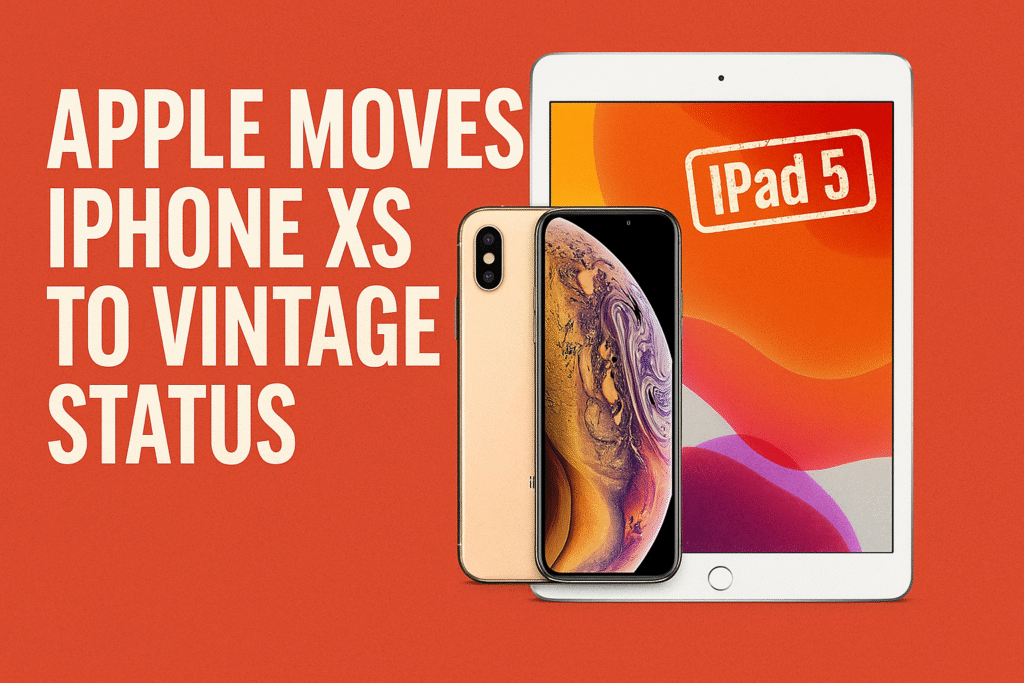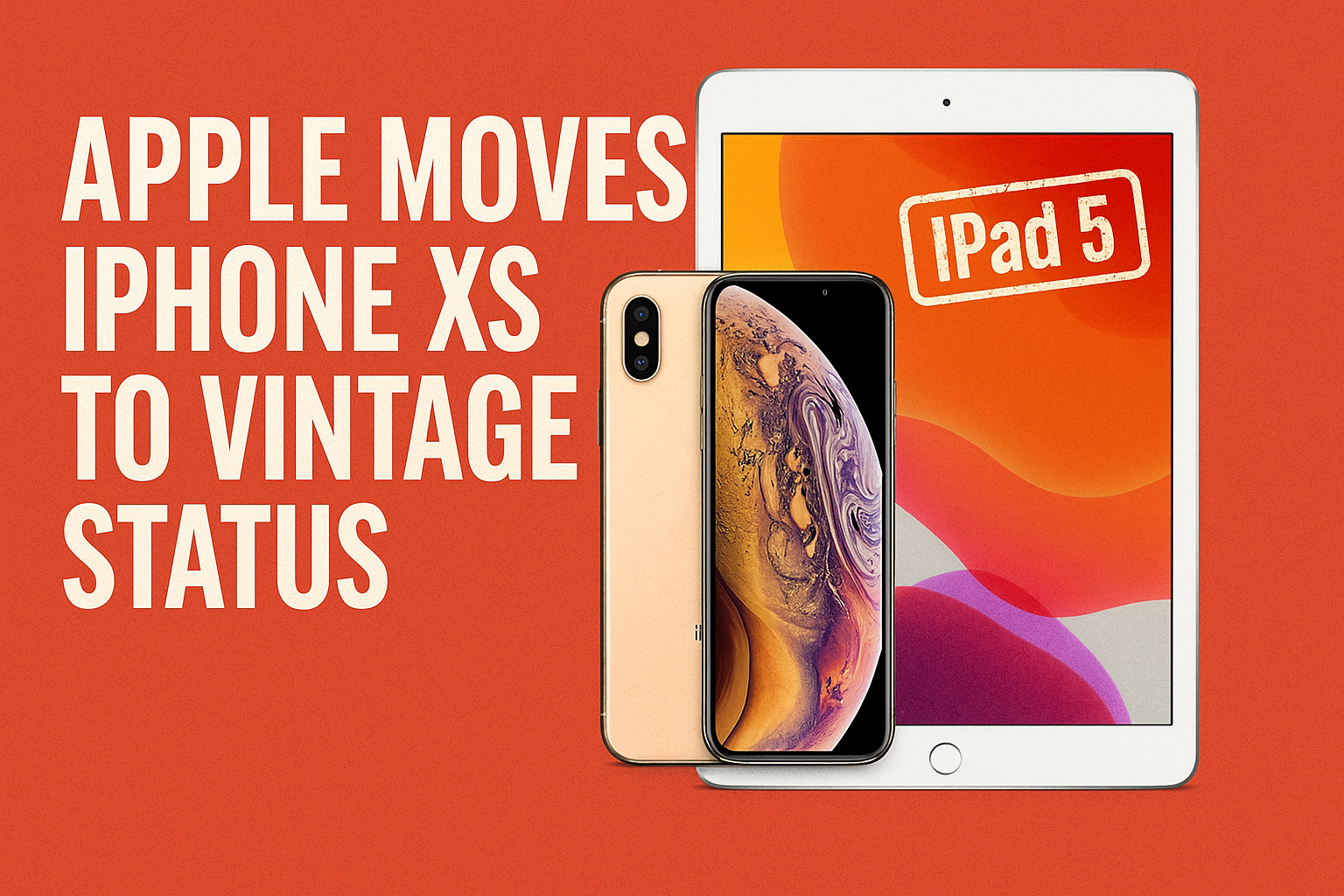
Apple Moves iPhone XS to Vintage Status — a decision that has stirred nostalgia and raised questions among tech enthusiasts and long-time iPhone users. The once-flagship device, launched with much fanfare in September 2018, has officially been added to Apple’s vintage list. As Apple users digest this update, it marks another milestone in the tech giant’s ever-evolving product lifecycle.
What Does “Vintage” Status Mean?
Under Apple’s policy, a product is classified as vintage when five years have passed since the company last sold it through official retail channels. When Apple moves iPhone XS to vintage status, it indicates that the device has reached that milestone and is approaching obsolescence. While this doesn’t immediately cut off all support, it significantly impacts service eligibility.
Repairs might still be available, but only at Apple Stores or authorized service providers, and only if spare parts remain in stock. So, while you might still be able to fix your iPhone XS today, that window is closing rapidly.
Timeline of iPhone XS Lifecycle
Let’s take a moment to reflect on the journey of the iPhone XS. The device launched in September 2018, replacing the iPhone X and boasting the powerful A12 Bionic chip, dual SIM capability, and improved camera technology. By 2019, Apple discontinued the iPhone XS in favor of the newer iPhone 11 series.
However, third-party resellers continued to offer the iPhone XS well beyond its official shelf life, extending its reach. Now, in 2025, Apple has made the inevitable call—Apple moves iPhone XS to vintage status, drawing the curtain on a significant chapter in smartphone history.
Implications for iPhone XS Users
The immediate effect of this classification is the gradual reduction in support. When Apple moves iPhone XS to vintage status, it signals that the device will receive fewer repair options. In two more years, it will be declared obsolete, meaning no further service will be provided, even if replacement parts are somehow available.
This looming deadline is crucial for users still relying on their iPhone XS. While the device may still function smoothly, issues such as battery degradation or screen failures could become harder—and costlier—to address.
iPhone XS Max: Already on the List
Interestingly, the iPhone XS Max, the XS’s larger sibling, had already been added to the vintage list back in November 2024. This model, featuring a 6.5-inch display and the same A12 chip, offered a larger screen experience but was essentially a parallel offering to the XS.
When Apple moves iPhone XS to vintage status, it reunites the two devices in the digital archives of Apple’s legacy, reminding users of how quickly innovation progresses in the tech world.
iPad 5 Goes Obsolete
While Apple moves iPhone XS to vintage status, the company also declared the fifth-generation iPad (iPad 5) obsolete. Released in 2017, this iPad was already classified as vintage. Now, Apple has ended all hardware services for the iPad 5, regardless of whether spare parts are in stock.
This shift reinforces Apple’s strict hardware support policy. It underlines that, once obsolete, Apple devices cannot be serviced—even by authorized partners.
The Curious Case of the Mac Mini 2018
As Apple moves iPhone XS to vintage status, the company has also made subtle adjustments to other products’ support status. The 2018 Mac mini, a device that many believed would enjoy a longer support window, has also been listed as vintage. Apple’s support page now advises users of this model to check with authorized service providers for repair eligibility.
The early shift of the 2018 Mac mini to vintage status has puzzled many Apple observers. It raises questions about how Apple evaluates the lifecycle of less mainstream devices.
A Strategic Signal from Apple
When Apple moves iPhone XS to vintage status, it’s not just a routine update; it’s a strategic message. Apple maintains a tight hardware lifecycle, systematically encouraging users to upgrade. Devices from 2018 are now on the edge of extinction in the Apple ecosystem.
For the company, this move helps reduce the burden on support infrastructure while also promoting sales of newer models. For users, however, it’s a cue to start planning ahead. If you’re still using the iPhone XS, it’s time to consider backing up your data and exploring upgrade options.
What Made the iPhone XS Special?
The iPhone XS may not have been revolutionary like its predecessor, the iPhone X, but it was undoubtedly a solid upgrade. It introduced:
- A12 Bionic Chip: Offering faster performance and better energy efficiency.
- Enhanced Camera: Improved Smart HDR and advanced image signal processing.
- Dual SIM Capability: A first for iPhones, enabling eSIM support.
- Stunning OLED Display: A crisp and vibrant Super Retina screen.
As Apple moves iPhone XS to vintage status, it reminds users of the device’s contributions to Apple’s technological timeline.
Transitioning to a New Device
With this update, iPhone XS users should begin evaluating upgrade options. Whether it’s the iPhone 14, 15, or waiting for the upcoming iPhone 17, the transition plan depends on individual needs and budgets.
Remember, the move isn’t just about losing service access. As apps grow more resource-intensive and iOS updates leave older devices behind, staying on vintage hardware can limit the digital experience.
Final Two Years Before Obsolescence
Now that Apple moves iPhone XS to vintage status, it has about two years before becoming officially obsolete. That means no more software updates, no guaranteed compatibility with new apps, and zero hardware support.
If you value long-term functionality, start preparing for a new device. Trade-in programs or resale markets may offer some value while the iPhone XS still retains relevance.
The Bigger Picture: Apple’s Ecosystem Management
Apple has mastered the art of ecosystem control. When Apple moves iPhone XS to vintage status, it’s executing a planned obsolescence strategy that keeps its ecosystem fresh and its customers continuously upgrading.
This ensures that only the most secure, up-to-date devices are part of the mainstream user base—benefitting both users and the company.
Conclusion
Apple moves iPhone XS to vintage status, and with that, a chapter in smartphone history draws to a close. For many, the iPhone XS was a reliable workhorse—modern enough to handle heavy tasks and elegant enough to turn heads. But now, its days of frontline service are numbered.
With Apple gradually phasing out support, users must adapt. Whether that means upgrading, trading in, or simply appreciating the twilight years of their device, the message is clear: time waits for no tech.

One thought on “Apple Moves iPhone XS to Vintage Status, iPad 5 Obsolete Before iPhone 17 Launch”
Comments are closed.